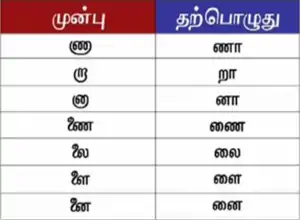Simplified Tamil script
Simplified Tamil script or Reformed Tamil script refers to several governmental reforms to the Tamil script.

| ணா ṇā | ணை ṇai | ணொ ṇo | ணோ ṇō |
| லை lai | |||
| ளை ḷai | |||
| றா ṟā | றொ ṟo | றோ ṟō | |
| னா ṉā | னை ṉai | னொ ṉo | னோ ṉō |
In 1978, the Government of Tamil Nadu reformed certain syllables of the modern Tamil script with view to simplify the script.[1] It aimed to standardize non-standard ligatures of ஆ ā, ஒ o, ஓ ō and ஐ ai syllables.[2] These reforms only spread in India and the digital world, whereas Sri Lanka, Singapore, Malaysia, Mauritius, Reunion and other Tamil speaking regions continue to use the traditional syllables.
Furthermore, only 13 out of 15 of the proposed simplifications were successful as people continued to use ஐ ai instead of the proposed அய் ay and ஔ au instead of the proposed அவ் av.[3]
History
Periyar E. V. Ramasamy was one of the people to suggest script reform.[4] A Script Reform Committee was formed in 1947 under Periyar E. V. Ramasamy, while in 1951 the Government of Tamil Nadu accepted its recommendations, it failed to enforce them.[5] He encouraged it on the basis that it allegedly eased learning and writing.[6]
References
- Bellary Shamanna Kesavan, Prathivadibayangaram Narasimha Venkatachari (1984). History of printing and publishing in India: a story of cultural re-awakening, Volume 1. National Book Trust. p. 82.
- Unicode Consortium. (2019). South and Central Asia I: Official Scripts of India. In The Unicode Standard, Version 12.0 (pp. 489–498).
- Mello, Fernando. "Evolution of Tamil typedesign" (PDF). Evolution of Tamil typedesign. Archived from the original (PDF) on 11 March 2012. Retrieved 31 December 2011.
- Caṇmukam, Ce. Vai. (1983). Aspects of language development in Tamil. All India Tamil Linguistics Association. p. 96.
- James, Gregory (2000). Colporuḷ: a history of Tamil dictionaries. Cre-A.
- N., Jayapalan (2001). History Of India(from National Movement To Present Day). Atlantic Publishers & Dist. p. 169.
